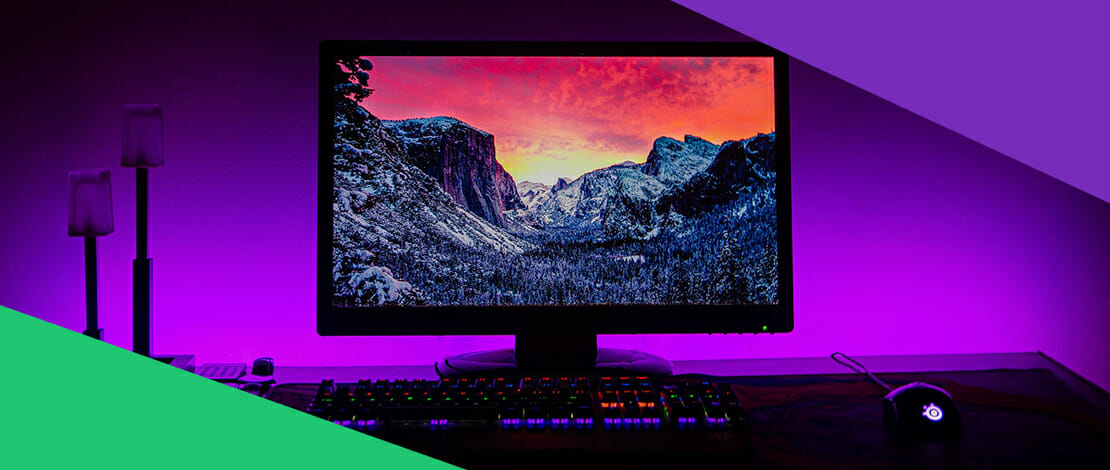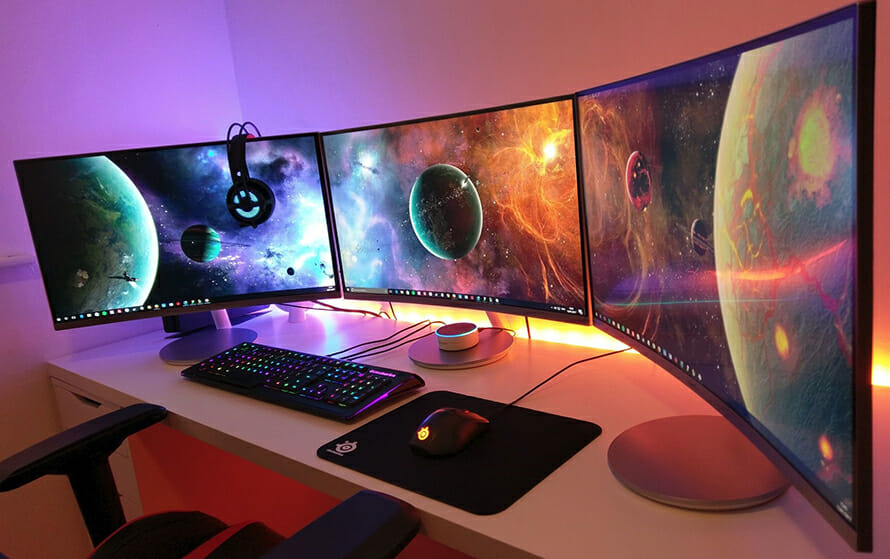Curved Monitor vs Flat. Which One is Better for Gaming and Work?

Display technology has been one of the fastest advancing industries in the past two decades. Monitors and TVs used to weigh much more when cathode-ray tube technology was used. Today, LCD technology is primarily used to power displays, while OLED displays are actively being developed for possible mainstream usage.
The display technology can matter for different types of work, like high refresh rate gaming and color accuracy sensitive work. But, for most people, whether a monitor is curved or flat is even more important.
Gaming and work can be two completely different activities, so a flat or curved monitor may suit one better or another. Following is a breakdown of what makes a curved or flat monitor better, as well as what makes them sub-optimal.
Curved Monitor Vs Flat – An Introduction
Flat monitors have been around since 1958, the first one being an almost fully flat CRT monitor. In 1968, functional models of an LCD screen were available. The twisted nematic field effect (TN) was patented in 1970, a form of LCD implementation that made LCDs viable in almost all applications, from calculators to huge screens.
LCD technology had a steady development in the 1980s and 1990s and has been steadily replacing CRT monitors, which are now used in esoteric situations like vintage gaming.
In 2013, through the efforts of LG and Samsung, curved screen monitors were introduced to the world. Curved screens allow wider monitors to be used from a reasonable distance away from the desk, allowing a wider field of view.
A wider field of view, particularly on a physical level, provides the user with a better sense of immersion, typically used in a gaming context. However, there are limitations to both screen types, even though they might not be obvious.
The Benefits and Disadvantages
Flat monitors make most of the market. They are cheaper to produce and replace and are better suited to work that requires color accuracy and minimal color distortion when changing viewing angles. Flat monitors also make for some of the best affordable gaming monitors, most often high refresh rate TN panels.
Flat-screen TVs are far more common, with only a few curved screen TVs being produced by Samsung. However, curved screens have their advantages, and they are best observed in relatively close viewing distance environments.
Curved screens are typically used for larger monitors and wider monitors, in close quarters situations. They are rated, for example, as having a curvature of 1000R. The R is the radius and the number is the distance between the center of the circle to its perimeter. The number refers to millimeters, and so, a 1800R monitor would have a radius of three meters. The screen size is still displayed in inches.
The bigger the number, the larger the screen and the less noticeable the curvature is. The Samsung Odyssey monitors are very curved, at a 1000R or 1800R ratio.
They would be best viewed from a viewing distance not longer than 1 meter. The curvature of the monitor also serves as a recommendation for the maximum viewing distance. A 4000R monitor can be viewed without unpleasantness from no more than 4 meters.
Both curved and flat monitors can be overclocked, allowing a higher refresh rate, while consuming more power.
Curved Vs Flat Monitor Gaming – Curved Monitors Excel
Curved monitors were designed to mimic human vision. Human vision has a field of view which is very similar to that of a 1000R monitor. When viewing a curved monitor, we tend to have much less peripheral distortion, which manifests as distortion on the edges of a monitor, especially large monitors up close.
Curved monitors are, according to a medical study from Harvard, less tiring and more comfortable.
There are specialized, color-accurate curved monitors for professionals, but the industry typically prefers flat-screen monitors for that kind of work.
The reason is viewing angles.

Curved Vs Flat Monitor for Gaming – Flat Monitors are Simpler
Most gamers require two things from their monitors, a high refresh rate and good immersion. Flat monitors can give great immersion, provided that you are not sitting really close to a 32” screen.
Flat monitors are easier and cheaper to produce and offer a variety of panels, TN, IPS and VA, while curved monitors are only IPS and VA. Those who need a high refresh rate and low latency should turn to TN panels by default, which is not an option with curved monitors.
Flat monitors have predictable viewing angles, IPS being the best among them. An IPS monitor can be viewed from almost any angle without much distortion and without any in normal working conditions.
While immersion might be better for some people with curved monitors, flat monitors are not as pricey and even 240Hz gaming monitors can be purchased for reasonable amounts of money.
That leaves us with the question of professional work.
Curved Vs Flat Monitor for Work – Flats Do Better Most of the Time
Professionals who have done work on flat monitors often prefer staying flat monitors. Most professional-grade, color-accurate monitors are flat monitors. While there are attempts to make color-accurate curved monitors, the very curvature of the screen makes it a more difficult challenge.
However, professional work can be anything from writing to coding, where a curved monitor might help with long work hours. Even two curved monitors can be used, though only horizontally.
Summary and Conclusion
Both curved and flat monitors have their pros and cons. Flat monitors have better viewing angles and are often cheaper than their curved counterparts. They do cause more eye soreness and unpleasantness, which has to do with peripheral distortion (encountered when looking at large screens from close by).
Curved monitors offer better immersion and are less tiring, but cost more and have worse viewing angles. Both types have high-quality VA and IPS panels, and both offer a high refresh rate, with curved monitors slowly getting better color accuracy.
Whether for gaming or work, choosing a flat or curved monitor boils down to the user’s preference, budget and desk space.